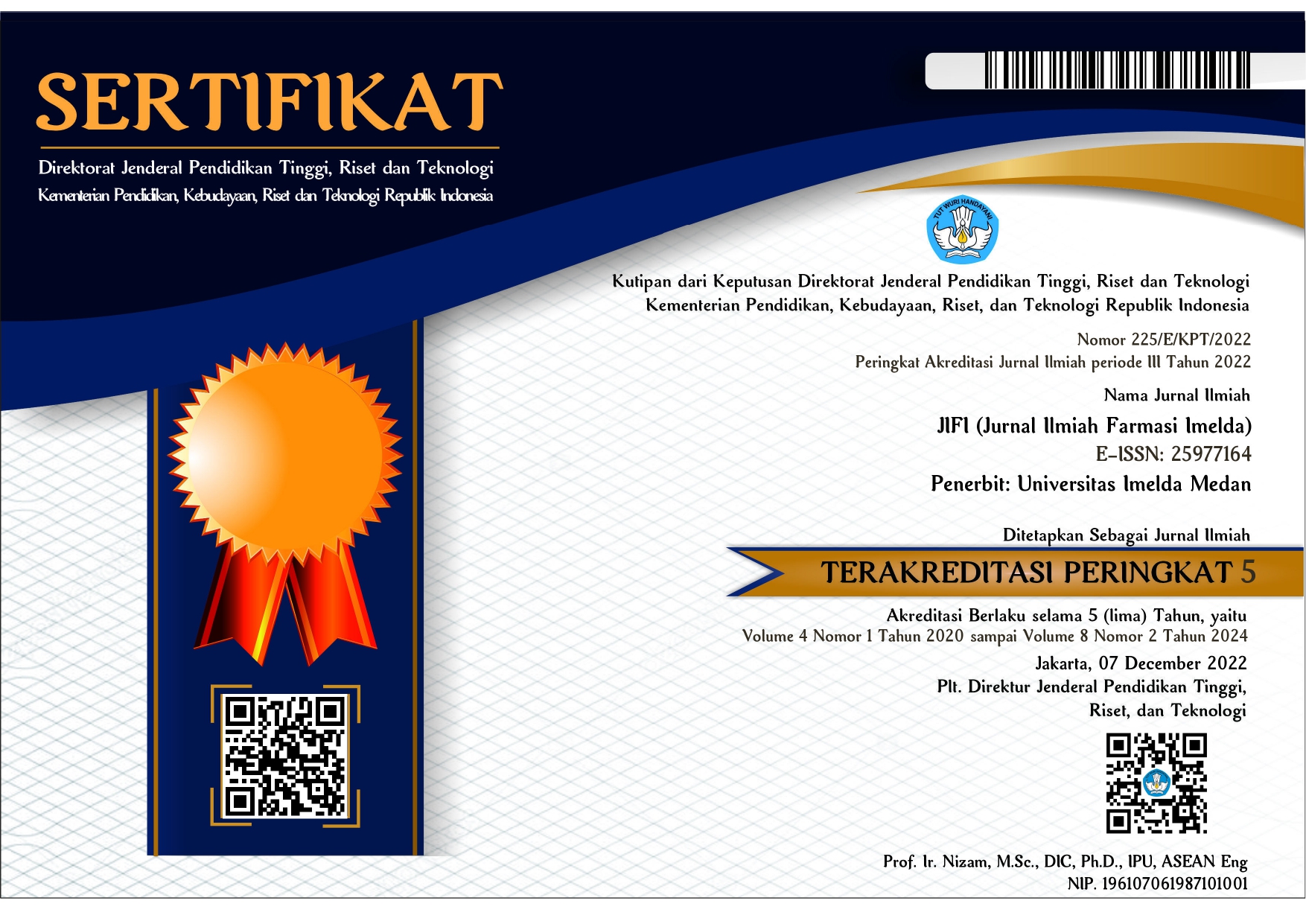EVALUASI PENGGUNAAN ANTIBIOTIK PADA PASIEN PEDIATRI DI INSTALASI RAWAT INAP UPTD KHUSUS RUMAH SAKIT UMUM HAJI MEDAN TAHUN 2024
DOI:
https://doi.org/10.52943/jifarmasi.v9i1.1923Kata Kunci:
Child, Evaluation , Antibiotic Use, ATC/DDDAbstrak
One of the health problems is infection. Bacteria are the most common cause. Antibiotic use is increasing because of more bacterial infections. This condition can cause the risk of antibiotic resistance. In children, antibiotic resistance can occur in conditions that impact mortality, morbidity, and high medical costs. This study aims to determine the evaluation of antibiotic use and a description of the evaluation of antibiotic use with the ATC/DDD method from medical records of hospitalized patients receiving antibiotic therapy. The research method used is observational research (non-experimental) with a quantitative approach, which includes analysis of patient characteristics and antibiotic use patterns. The results showed that the cephalosporin antibiotic group (80.4%) was used most often. The most common type of antibiotic used was ceftriaxone (38.8%). The most common type of treatment was intravenous (56.1%). In quantitative evaluation using the ATC/DDD method, the antibiotic with the highest DDD/100 patient days value was cefixime, with 124.46, and the antibiotic with the lowest DDD/100 patient days value was Ripampicin, with 0.04. The conclusion of this study is based on the analysis of antibiotic use using the ATC/DDD approach, regarding the Medan Haji General Hospital in 2024. Antibiotic use was evaluated using the ATC/DDD approach, resulting in a total DDD/100 inpatient days value of 202.11%. Cefixime had the highest DDD/100 inpatient days value, which was 120.15%, with a total antibiotic length of stay (LOS) of 325 days.
Referensi
Frieden T. (2013). Antibiotic resistance threats. 22–50. https://doi.org/CS239559-B
Khalili, H., & Izadpanah, M. (2015). Antibiotic regimens for treatment of infections due to multidrug-resistant Gram-negative pathogens: An evidence-based literature review. Journal of Research in Pharmacy Practice, 4(3), 105. https://doi.org/10.4103/2279-042x.162360
Permenkes RI. (2021). Pedoman Penggunaan Antibiotik. Permenkes RI, 1–97.
Purwaningsih, A. E. D. A., Rahmawati, F., & Wahyono, D. (2015). Evaluasi Penggunaan Antibiotik Pada Pasien Pediatri Rawat Inap. Jurnal Manajemen Dan Pelayanan Farmasi, 5(3), 211–218.
Putra, D. P., & Kusmiati, T. (2019). Manajemen Pemberian Antibiotik dengan Hasil Uji Kepekaan Resisten. Jurnal Respirasi, 1(1), 7. https://doi.org/10.20473/jr.v1-i.1.2015.7-14
Rachmawati, S., Masito, D. K., & Rachmawati, E. (2020). Evaluasi Penggunaan Antibiotik pada Pasien Anak Rawat Inap di RSD Dr. Soebandi Jember. Jurnal Farmasi Galenika (Galenika Journal of Pharmacy) (e-Journal), 6(2), 212–220. https://doi.org/10.22487/j24428744.2020.v6.i2.14976
Sari, D. K., & Darmawan, M. (2010). Faktor Risiko Terjadinya Syok pada Infeksi Dengua Anak Di RSUD Panembahan Senopati Bantul. In Jurnal Kedokteran dan Kesehatan Indonesia (Vol. 2, Issue 6, pp. 37–46).
Virginia, D. M. (2014). Virginia.Pdf. In Peresepan Sediaan Racikan Pada Pasien Anak di Bangsal Rawat Inap: Vol. 18 No.1 (pp. 56–61).
World Health Organization. (2017). Chronic Respiratory. Guidelines for ATC Classification and DDD Assignment 2018 (21st Ed.). Oslo Norway: WHO Collaborating Centre for Drug Statistics Methodology.
Zhang, L., Huang, Y., Zhou, Y., Buckley, T., & Wang, H. H. (2013). Antibiotic administration routes significantly influence the levels of antibiotic resistance in gut microbiota. Antimicrobial Agents and Chemotherapy, 57(8), 3659–3666. https://doi.org/10.1128/AAC.00670-13
##submission.downloads##
Diterbitkan
Terbitan
Bagian
Lisensi
Hak Cipta (c) 2025 JIFI (Jurnal Ilmiah Farmasi Imelda)

Artikel ini berlisensi Creative Commons Attribution-NonCommercial 4.0 International License.








